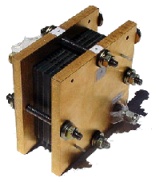
Fuel Cells have a bright and important future, highly efficient and suited to portable power generation, batteries might soon be consigned to history. Huge strides in fuel cell research have been made to bring efficiency and more importantly cost effectiveness to consumer level.
Accurately determining efficiency, diagnosing potential problems, or quality control (QC) for fuel cells can be undertaken by an electrochemical technique called Electrochemical Impedance Spectroscopy (EIS). EIS works by outputting sine waves across a sweep of frequencies (µHz to KHz), whilst at the same time measuring potential and galvanic response sine waves, from which impedance and phase angle of the fuel cell can be computed across a frequency range. Further mathematical calculations give Z real and Z imaginary, plotted on a Nyquist graph.
ACM are proud with the technological advancement made in the field of EIS (also known as AC Impedance), with dedicated Digital Signal Processor (DSP) electronics we are able to output a Sine wave at 100KHz, whilst at the same time measure in the many MHz (1,000,000 Hz and above), this leads to true data collection (often manufacturers will sample at frequencies lower than the sine frequency!!) which is collected over complete mains cycles, this nullifies the effect that mains interference has on data results. Interference not only can appear from mains, but also from other modern hi-tech machinery, such as computer systems. All ACM systems employ an optically isolated interface to the PC and internal floating ground isolation.
Gill ACs are very suited to fuel cell testing, many Gill ACs can be paralleled up from the same computer to test multiple fuel cells. A preferred option for economical testing is the Gill 8 a multi-channel sequential instrument.
High current and potentials can utilized with a load, as described by Battery Engine.
The innovative Microbial Fuel Cell (MFC) is used for water treatment, power generation, methane production and as a biosensor. To aid in the development of this technology researchers use the techniques of cyclic voltammetry, AC impedance, static potentials and ZRA coupling. Our Gill AC and Gill 8 are ideal for MFC testing in the lab, with the Field Machine the one to pick for working installations.
See Application Notes for more information on AC Impedance (also known as EIS) plus many more.
See Downloads for instrumentation datasheets.
